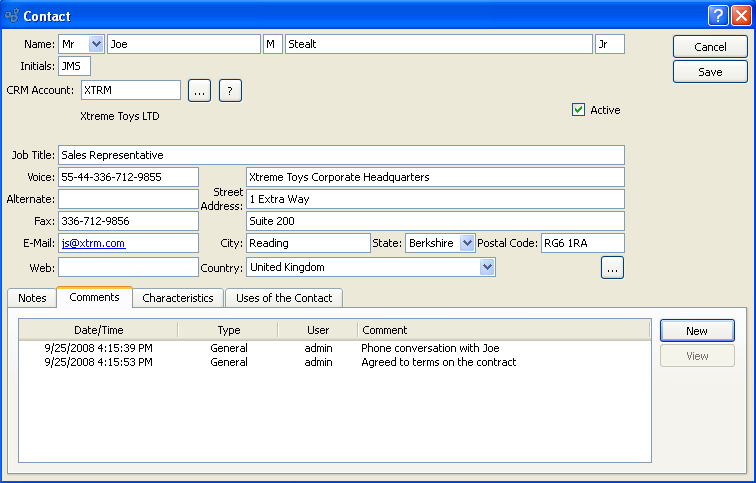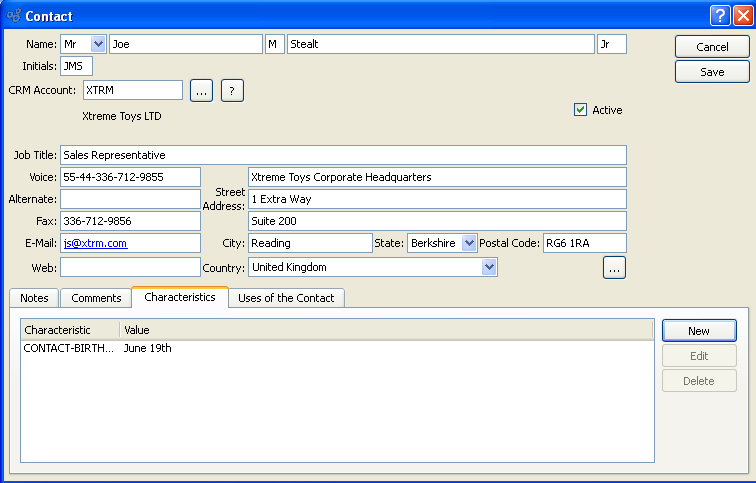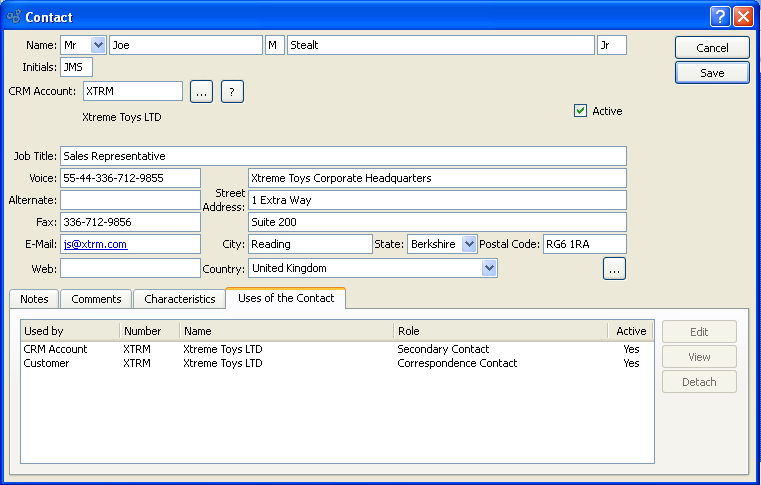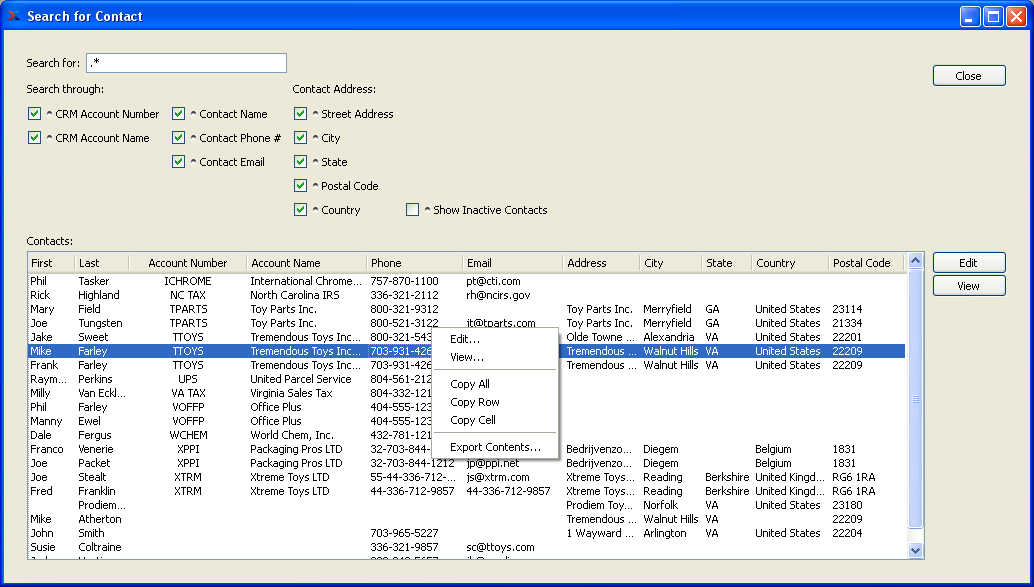CRM Contact section.
Contacts are people who may be associated directly with CRM Accounts, Customers, Ship-To Addresses, Vendors, Vendor Addresses, and Sites. To create a new Contact, select the "New Contacts" option. The following screen will appear:

When creating a new Contact, you are presented with the following options:
- Title
Select a Title from the list of available Titles.
- First
Enter the Contact's first name.
- Last
Enter the Contact's last name.
- Initials
Enter the Contact's initials.
- CRM Account
Specify the CRM Account the Contact is associated with (if any). Contacts may also be attached to a CRM Account on the Account master.
- Active
Select if you are actively doing business with this Contact. Not selecting makes the Contact inactive.
- Job Title
Enter the Contact's job title.
- Voice
Enter the Contact's phone number.
- Alternate
Enter an alternate phone number for the Contact.
- Fax
Enter the Contact's fax number.
Enter the Contact's e-mail address.
- Web
Enter the Contact's website address.
Note
If a new Address is manually entered here, that Address will be added automatically to the master list of Addresses.
- Address
Manually enter Address information in the fields below—or use the browse button to select pre-existing Address information. If a new Address is manually entered here, that Address will be added automatically to the master list of Addresses. For additional documentation related to creating Addresses, see Section 8.1, “ New Address”.
- Notes
This is a scrolling text field with word-wrapping for entering Notes related to the Contact. Any Notes entered on this screen are for internal purposes only.
To add Comments to a Contact, select the "Comments" tab at the bottom of the "Contact" screen. The following screen will appear:

When adding or reviewing Comments, you are presented with the following options:
- Verbose Text
Select to display all Comments in the list in an expanded view which includes the entire text of each Comment. To edit a Comment, simply select the "Edit" link next to the Comment. That link will not be shown for Changelog Comments, which can't be edited. If the "Verbose Text" option is not selected, the Comment list will display only header level information for each Comment.
- Comments
Display lists Comments related to the record.
To the far right of the screen, the following buttons are available:
- NEW
Opens screen for creating a new Comment.
- VIEW
Highlight a Comment and then select this button to reach a read-only view of the "Edit" screen.
- EDIT
Enables you to edit highlighted Comments—as long as the Comments are not "ChangeLog" Comments. ChangeLog Comments are system-generated and may not be edited. The edit screen is the same as that for creating a new Comment—except that when editing, the fields will contain Comment information. Double-clicking on a Comment will also bring you to the editing screen.
To enter a new Comment, select the NEW button. The following screen will appear:

- Comment Type
Select a Comment Type from the drop-down list to classify the Comment. This is a required step. Comment Types may be system-defined (i.e., "ChangeLog" and "General") or user-defined, as described in Section 13.12, “Comment Types”. Once you have specified a Comment Type, begin typing your Comment in the main text area. The text area features word-wrapping and scroll-bar support for longer Comments.
To the far right of the screen, the following buttons are available:
- CANCEL
Closes the screen without creating the Comment, returning you to the previous screen.
- SAVE
Creates the Comment and adds it to the list of Comments.
- SHOW MORE
Select to show the complete list (i.e., "thread") of Comments associated with the record. To hide the list, simply select the SHOW MORE button again. The Comment thread will show the most recent Comment first.
Contact Characteristics are user-defined definitions of a Contact which may be used to provide additional layers of description. To enter Characteristics associated with a Contact, select the "Characteristics" tab. The following screen will appear:

Tip
Use Contact Characteristics, for example, to record and remember a Contact's birthday—or similar personal information.
- Characteristics
Display lists the Characteristics related to the Contact.
To the far right of the screen, the following buttons are available:
- NEW
Opens screen for creating a new Contact Characteristic.
- EDIT
Enables you to edit highlighted Contact Characteristics. The edit screen is the same as that for creating a new Contact Characteristic—except that when editing, the fields will contain Contact Characteristic information. Double-clicking on a Contact Characteristic will also bring you to the editing screen.
- DELETE
Highlight a Contact Characteristic and then select this button to remove the Contact Characteristic from the list.
To create a new Contact Characteristic, select the NEW button. The following screen will appear:

When creating a new Contact Characteristic, you are presented with the following options:
- Characteristic
Select a Characteristic from the list of Characteristics designated as being available for use as Contact Characteristics.
- Value
Enter a value to associate with the Characteristic.
To the far right of the screen, the following buttons are available:
- CANCEL
Closes the screen without creating the Contact Characteristic, returning you to the previous screen.
- SAVE
Creates the Contact Characteristic and adds it to the list of Contact Characteristics
To locate where in the application the Contact is used, select the "Uses of the Contact" tab. The following screen will appear:

The "Uses of the Contact" list displays information on all Contact cross-references, including used-at reference, CRM Account Number, CRM Account name, role, and active status.
To the far right of the list, the following buttons are available:
- EDIT
Enables you to edit highlighted used-at references.
- VIEW
Highlight a used-at reference and then select this button to reach a read-only view of the "Edit" screen.
Contacts are people who may be associated directly with CRM Accounts, Customers, Ship-To Addresses, Vendors, Vendor Addresses, and Sites. To access the master list of Contacts, select the "List Contacts" option. The following screen will appear:

The "List Contacts" screen displays information on all existing Contacts, including Contact first name, last name, Account number, Account name, phone number, alternate phone number, fax number, email address, and web address.
Tip
Web addresses will launch a web browser when selected. However, for this to work you must drop the http:// prefix from the web address. Instead use the form www.website.com.
To the far right of the list, the following buttons are available:
- CLOSE
Closes the screen, returning you to the application desktop.
Runs the report associated with this screen.
- NEW
Opens screen for creating a new Contact.
- EDIT
Enables you to edit highlighted Contacts. The edit screen is the same as that for creating a new Contact—except that when editing, the fields will contain Contact information. Double-clicking on a Contact will also bring you to the editing screen.
- VIEW
Highlight a Contact and then select this button to reach a read-only view of the "Edit" screen.
- DELETE
Highlight a Contact and then select this button to remove the Contact from the list.
To search for a Contact, select the "Search for Contact" option. The following screen will appear:

When searching to retrieve Contact information from the database, you are presented with the following options:
- Search for
Enter any character or combination of characters you want to match, followed by the TAB key. The "Search for" field supports pattern matching with Regular Expressions.
Tip
Hitting the TAB key activates the search operation.
- Search through
Specify which of the following criteria you want to include in the search:
- CRM Account Number
Select to search by CRM Account Number.
- CRM Account Name
Select to search by CRM Account Name.
- Contact Name
Select to search by Primary Contact Name.
- Contact Phone #
Select to search by Primary Contact Phone Number.
- Contact Email
Select to search by Primary Contact Email Address.
- Street Address
Select to search by Primary Contact Street Address.
- City
Select to search by Primary Contact City.
- State
Select to search by Primary Contact State.
- Postal Code
Select to search by Primary Contact Postal Code.
- Country
Select to search by Primary Contact Country.
- Show Inactive CRM Accounts
Select to show inactive Contact as well as active Contact.
- Contacts
Display will show search results for Contacts, using specified parameters.
To the far right of the screen, the following buttons are available:
- CLOSE
Closes the screen, returning you to the application desktop.
- EDIT
Enables you to edit highlighted Contact. The edit screen is the same as that for creating a new Contact—except that when editing, the fields will contain Contact information. Double-clicking on a Contact will also bring you to the editing screen.
- VIEW
Highlight a Contact and then select d this button to reach a read-only view of the "Edit" screen.